 |
 |
 |
 |
 |
 |
| |
 |
|
 |
 |
 |
  |
  |
 |
 |
 |
 |
|
|
 |
|
 |
 |
 |
BUILDING |
 |
|
 |
|
 |
 |
 |
| |
 |
| 
 |
Longitude 131°
|
|
 |
 |
 |
 |
DESIGNER |
 |
|
|
 |
|
 |
 |
 |
| |
 |
|
 |
 |
 |
 |
CONTEXT |
 |
|
|
 |
|
 |
 |
 |
| Location |
 |
|
 |
 Uluru-Kata Tjuta National Park was inscribed on the World Heritage listing in two stages, initially in 1987 for its outstanding natural values and then in 1994 for its outstanding cultural values. Uluru-Kata Tjuta National Park was inscribed on the World Heritage listing in two stages, initially in 1987 for its outstanding natural values and then in 1994 for its outstanding cultural values.
The Park is distinguished by two significant landmarks, Uluru - formerly more popularly known as Ayers Rock - and Kata Tjuta, commonly known as The Olgas.
Covering 1,325 square kilometres, Uluru-Kata Tjuta National Park is jointly managed by Parks Australia, a federal government agency and the traditional Aboriginal owners, to whom ownership was officially granted on October 26, 1985.
Tourists first visited the region in the 1930s and since tourist numbers were first recorded in 1962/63 (5,462), the number of visitors has soared.
There is no direct English translation for Uluru (Ayers Rock), however, in local Anangu Pitjantjatjara language Kata Tjuta (the Olgas) means ‘many heads’. |
|
 |
 |
 |
|
 |
|
| Relationship with the location |
 |
|
 |
|
 |
 |
 |
 |
 |
 |
 |
DESCRIPTION |
 |
|
|
 |
|
 |
 |
 |
| . |
 |
|
 |
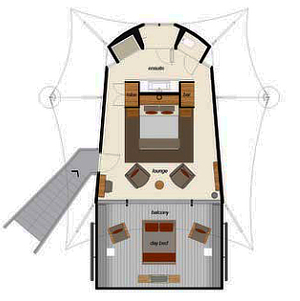 Longitude 131° is among Australia’s most acclaimed luxury wilderness retreats - an exclusive collection of 15 tented pavilions with unrivalled views of the country’s best-known natural wonder, Uluru (Ayers Rock). Longitude 131° is among Australia’s most acclaimed luxury wilderness retreats - an exclusive collection of 15 tented pavilions with unrivalled views of the country’s best-known natural wonder, Uluru (Ayers Rock).
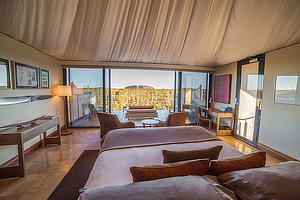 Situated discreetly adjacent to the World Heritage-listed Uluru-Kata Tjuta National Park, it offers superb contemporary accommodation in the style of a luxury desert camp, right at Australia’s spiritual heart. Situated discreetly adjacent to the World Heritage-listed Uluru-Kata Tjuta National Park, it offers superb contemporary accommodation in the style of a luxury desert camp, right at Australia’s spiritual heart.
Each of its tents has been carefully designed to have minimal impact on the delicate natural environment, standing lightly upon red sand dunes to provide an intimate encounter with the vast and unspoilt outback landscape.
Designed by respected Australian architect Philip Cox and first opened in 2003, Longitude 131° has recently undergone a multi-million dollar transformation under the stewardship of Baillie Lodges which took over operation of the property in late 2013.
Stylish new balconies have been added to each tent, creating contemporary outdoor living areas while enhancing views of Uluru. Designed by architect Max Pritchard, they have been fitted with day beds, armchairs and EcoSmart fireplaces, extending the luxury of Longitude 131° outdoors.
Other recent enhancements include artworks and artefacts commissioned from local Indigenous artists in a collaboration between Longitude 131° and nearby communities, providing a mix of ancient concepts and modern techniques. They have been combined with stylish new fabrics and soft furnishings which reflect the rich ochres, midnight blues and subtle greens of the desert.
The Baillie Lodges signature “Baillie Bed” has been introduced in all tents, as well as new staff uniforms designed exclusively by Australian bush outfitters RM Williams. Newly commissioned furniture by Arthur G and Pierre and Charlotte Julian have been introduced, along with dining ceramics by Malcolm Greenwood. |
|
 |
 |
 |
|
 |
|
| Original Design & Construction |
 |
|
 |
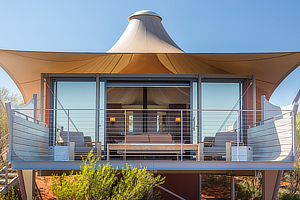 Longitude 131° was designed by renowned Australian architect Philip Cox, and construction was managed by Bovis Lend Lease. Roads and pathways were marked out, fenced and screened and the entire construction process used only these areas to protect the natural vegetation and fragile landscape. When construction was complete, these same roads and paths became the only vehicular and pedestrian access. Longitude 131° was designed by renowned Australian architect Philip Cox, and construction was managed by Bovis Lend Lease. Roads and pathways were marked out, fenced and screened and the entire construction process used only these areas to protect the natural vegetation and fragile landscape. When construction was complete, these same roads and paths became the only vehicular and pedestrian access.
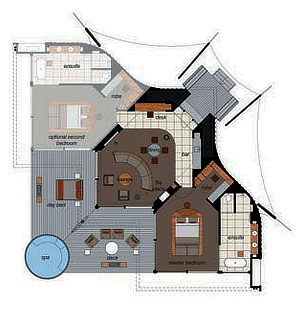 To minimise the use of concrete and the resultant need for heavy concrete trucks onsite, tents were prefabricated and assembled like a jigsaw puzzle. The largest vehicle acceptable on site was a utility, so component parts were limited in size to those that could fit onto a utility. To minimise the use of concrete and the resultant need for heavy concrete trucks onsite, tents were prefabricated and assembled like a jigsaw puzzle. The largest vehicle acceptable on site was a utility, so component parts were limited in size to those that could fit onto a utility.
A special screw pile construction was employed to install the guest tents, utilising hole diggers and pile applicators attached to the end of a telescopic arm.
Guest tents are designed to “float” above the sandy desert floor. Any sand requiring removal from under the building footprint was removed by hand. The entire property is designed so that it could be dismantled and relocated, with the current location returned to the its pre-developed state.
Even the swimming pool was pre-fabricated remotely and the sections bolted together on site, supported by the same screw pile foundations used to support the guest tents.
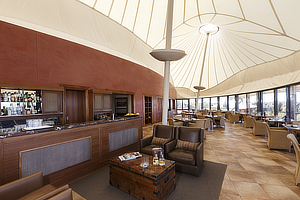 Construction was completed using the latest energy efficient design. Each guest tent has a fully glazed wall facing Uluru. Guests have the option of sleeping with the wall entirely open, with the protection of remote-controlled screen, or full block-out blinds. Construction was completed using the latest energy efficient design. Each guest tent has a fully glazed wall facing Uluru. Guests have the option of sleeping with the wall entirely open, with the protection of remote-controlled screen, or full block-out blinds.
The Dune House is a much larger structure, partially built into the side of the sand dune to maximise natural insulation and reduce energy needs. Solar panels cover the roof and provide hot water for the kitchen, guest tents and the pool. Guest tents are made up of three separate layers of fabric to enhance thermal and acoustic insulation and maintain a comfortable interior climate.
Floors are insulated and covered in natural stone to enhance cooling in summer and insulation in winter. The tents are positioned to minimise heat load on the glazing and solar heating is used to provide hot water. |
|
 |
 |
 |
|
 |
|
| . |
 |
|
 |
|
 |
 |
 |
 |
 |
 |
 |
VIDEO |
 |
|
|
 |
|
 |
 |
 |
| |
 |
|
 |
 |
 |
 |
LOCATION |
 |
|
|
 |
|
 |
 |
 |

|
 |

|
Continent |
|
 |
  Oceania |
|
Nation |
|
 |
  Australia |
|
Territory |
|
 |
  Northern Territory |
|
Town |
|
 |
  Yulara |
|
Place |
|
 |
  Uluṟu - Kata Tjuṯa National Park |
|
Address |
|
 |
  Napala Road (Lasseter Hwy) - Ayers Rock
|
|
|
|
 |
|
Telephone |
|
 |
|
Website |
|
 |
|
 |
 |
 |
 |
MAP |
 |
|
|
 |
|
 |
 |
 |
| |
 |
|
 |
 |
 |
 |
|
TYPOLOGY |
 |
|
|
 |
|
 |
 |
 |
|
|
 |
ARCHITECTURE | Buildings for travel and tourism
Hotels
| |
 |
 |
 |
 |
CHRONOLOGY |
 |
|
|
 |
|
 |
 |
 |
Project |
 |
|
 |
| 
 |
1999 - 2001
|
|
Realisation |
 |
|
 |
| 
 |
2001 - 2002 |
|
 |
 |
 |
 |
BIBILIOGRAPHIC REFERENCES |
 |
|
|
 |
|
 |
 |
 |
|
 |
| "Luxusunterkünfte am Ayers Rock / Luxury Accomodation at Ayers Rock", Detail 7-8/2005 [Dächer - flach, geneigt, gewelt / Roof Construction / Toitures], pp. 777-780, 887 |
|
|
"Architecture in Extreme Environments 2. Australia. Longitude 131°", Domus 870, maggio/may 2004, pp. 36-41
Joseph Grima, "Lusso estremo / Extreme luxury", Domus 870, maggio/may 2004, pp. 37, 40 (36-41) |
|
 |
 |
 |
 |
 |
 |
 |
CLIENT |
 |
|
|
 |
|
 |
 |
 |
| |
 |
General Property Trust
Voyages Hotels and Resorts, Sydney |
|
 |
 |
 |
 |
AMOUNT |
 |
|
|
 |
|
 |
 |
 |
| |
 |
|
 |
 |
 |
 |
DIMENSIONAL
DATA |
 |
|
|
 |
|
 |
 |
 |
| Number |
 |
|
 |
|
| Surface |
 |
|
 |
site sq.m. 1.100
each "tent" sq.m. 63
Dune pavilion sq.m. 153 |
|
 |
 |
 |
 |
STRUCTURES |
 |
|
|
 |
|
 |
 |
 |
| |
 |
Robert Bird & Partners
Sydney |
|
 |
 |
 |
 |
LANDSCAPE DESIGN |
 |
|
|
 |
|
 |
 |
 |
| |
 |
Tract Consultants
Mc Mahons Point |
|
 |
 |
 |
 |
STAFF |
 |
|
|
 |
|
 |
 |
 |
Project  |
 |
Cox Richardson Architects & Planners
Sydney |
|
|
 |
|
|
 |
|
Project architect |
 |
|
Construction management |
 |
|
Interior design |
 |
Christine le Fevre
HIP Group
Surrey Hills |
|
Mechanical engineer |
 |
|
Electrical engineer |
 |
|
Hydraulic engineer |
 |
|
Renovation plan |
 |
|
 |
 |
 |
 |
CREDITS |
 |
|
|
 |
|
 |
 |
 |
| |
 |
Text edited by Longitude 131°
Courtesy of Longitude 131°
|
|
 |
  |
 |
|
|